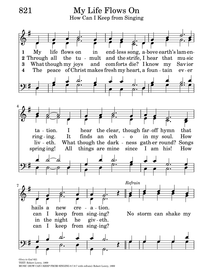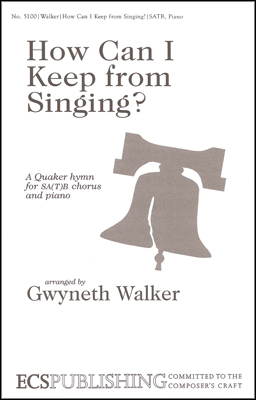- |
User Links
How Can I Keep from Singing

My life flows on in endless song, Above earth's lamentation
Author: AnonymousTune: HOW CAN I KEEP FROM SINGING
Published in 146 hymnals
Printable scores: PDF, MusicXMLAudio files: MIDI, Recording
Representative Text
1 My life flows on in endless song,
above earth’s lamentation.
I catch the sweet, though far-off hymn
that hails a new creation.
Refrain:
No storm can shake my inmost calm
while to that Rock I’m clinging.
Since Love is lord of heav’n and earth,
how can I keep from singing?
2 Through all the tumult and the strife,
I hear that music ringing.
It finds an echo in my soul.
How can I keep from singing? [Refrain]
3 What though my joys and comforts die,
I know my Savior liveth.
What though the darkness gather round?
Songs in the night he giveth. [Refrain]
4 The peace of Christ makes fresh my heart,
a fountain ever springing!
All things are mine since I am his!
How can I keep from singing? [Refrain]
Source: Voices Together #605
Author: Anonymous
In some hymnals, the editors noted that a hymn's author is unknown to them, and so this artificial "person" entry is used to reflect that fact. Obviously, the hymns attributed to "Author Unknown" "Unknown" or "Anonymous" could have been written by many people over a span of many centuries. Go to person page >Text Information
| First Line: | My life flows on in endless song, Above earth's lamentation |
| Title: | How Can I Keep from Singing |
| Author: | Anonymous |
| Language: | English |
| Copyright: | Public Domain |
- (hymns)
- (hymns)
- (hymns)
- (hymns)
- (hymns)
- (hymns)
- (hymns)
- (hymns)
- (hymns)
- (hymns)
- (hymns)
- (hymns)
- (hymns)
- (hymns)
- (hymns)
- (hymns)
- (hymns)
- (hymns)
- (hymns)
- (hymns)
- (hymns)
- (hymns)
- (hymns)
- (hymns)
- (hymns)
- (hymns)
- (hymns)
- (hymns)
- (hymns)
- (hymns)
- (hymns)
- (hymns)
- (hymns)
- (hymns)
- (hymns)
- (hymns)
- (hymns)
- (hymns)
- (hymns)
- (hymns)
- 1 Thessalonians 6:16-24 (hymns)
- (hymns)
- (hymns)
- Year C, Christmas season, First Sunday after Christmas Day
This is recommended for Year C, Christmas season, First Sunday after Christmas Day by 3 hymnal lectionary indexes including Glory to God: the Presbyterian Hymnal #821. - Year C, Lent, Fourth Sunday
This is recommended for Year C, Lent, Fourth Sunday by 3 hymnal lectionary indexes including Glory to God: the Presbyterian Hymnal #821.
English
- A Selection of Spiritual Songs: with music for the Church and the Choir #575
- Ancient and Modern: hymns and songs for refreshing worship #733
- Beloved Beer and Hymns: A Hymnal for the Thirsty #17
- Best Hymns No. 3: for services of song in Christian work #156
- Beulah Songs: a choice collection of popular hymns and music, new and old. Especially adapted to camp meetings, prayer and conference meetings, family worship, and all other assemblies... #38
- Breaking Bread (Vol. 39) #442
- Bright Jewels for the Sunday School: a new collection of Sunday School songs written expressly for this work, many of which are the latest compositions of William B. Bradbury... #16
- Calvary Selection of Spiritual Songs with Music for the Church and the Choir #d572
- Calvary Songs #20
- Calvary Songs for Sunday School & Families. Words ed. #d111 10 shown out of 109
Spanish
For Leaders
Text:
The text of this hymn first appeared in The New York Observer (1868), titles "Always Rejoicing," and attributed to "Pauline T." It appeared without attribution in The Christian Pioneer, Vol 23, page 53. William Bradbury included it in Bright Jewels for the Sunday School, published in 1869. Bradbury died a year before the collection was published. Robert Lowry was the designated editor. In that book, the initials “R.L.” appear above the music where the composer is credited, but the space for the author of the text is blank. However, “Shall We Gather at the River” (number 110 in Bright Jewels), which was unquestionably written entirely by Lowry, is attributed in the same way. The text was originally written in three long stanzas. Modern hymnals split the stanzas in half; the second half of the original second stanza is used as a refrain, and the first half of the original third stanza is omitted. It usually appears with four stanzas and a refrain. The theme of the text is Christian peace and joy, even in times of trial.
Tune:
Robert Lowry wrote the tune HOW CAN I KEEP FROM SINGING (also called ENDLESS SONG from the opening line of the first stanza) to accompany these words, and it appeared with the text in Bright Jewels in 1869. It was originally written in triple meter (3/2), but some modern hymnals have changed the tune to a slightly irregular duple meter (4/4) with a little syncopation. The tune is pentatonic with a consistent rhythmic pattern (in its original form), and works well when sung unaccompanied.
When/Why/How
This hymn can be used anytime as a reminder of the joy of faith, especially in times of trial. Most arrangements of this tune are rather quiet and have a peaceful mood, such as “Reflections on 'Endless Song'” a thoughtfully paced handbell arrangement, or the piano solo version in the collection ”Then Sings My Soul.” A simple arrangement suitable for smaller choirs, using the altered version of the tune, is “How Can I Keep from Singing” for SAB choir and keyboard accompaniment. “Endless Song” is another choral arrangement by Douglas Wagner using Lowry's original meter. One setting that emphasizes less of the quiet peace and more of the joy of singing is “How Can I Keep from Singing” by Robert A. Hobby with an upbeat brass and organ accompaniment.
Tiffany Shomsky, Hymnary.org
Timeline
Arrangements
Media
- MIDI file from Calvary Songs #20
- MIDI file from The Cyber Hymnal #2207
- Audio recording from Evangelical Lutheran Worship #763
- Audio recording from The Faith We Sing #2212
- Audio recording from Glory to God: the Presbyterian Hymnal #821
- Audio recording from Lift Up Your Hearts: psalms, hymns, and spiritual songs #443
- Audio recording from Lift Up Your Hearts: psalms, hymns, and spiritual songs #443
- Audio recording from Lift Up Your Hearts: psalms, hymns, and spiritual songs #443
- Audio recording from Worship and Rejoice #424
- MIDI file from Worship and Rejoice #424


 My Starred Hymns
My Starred Hymns







